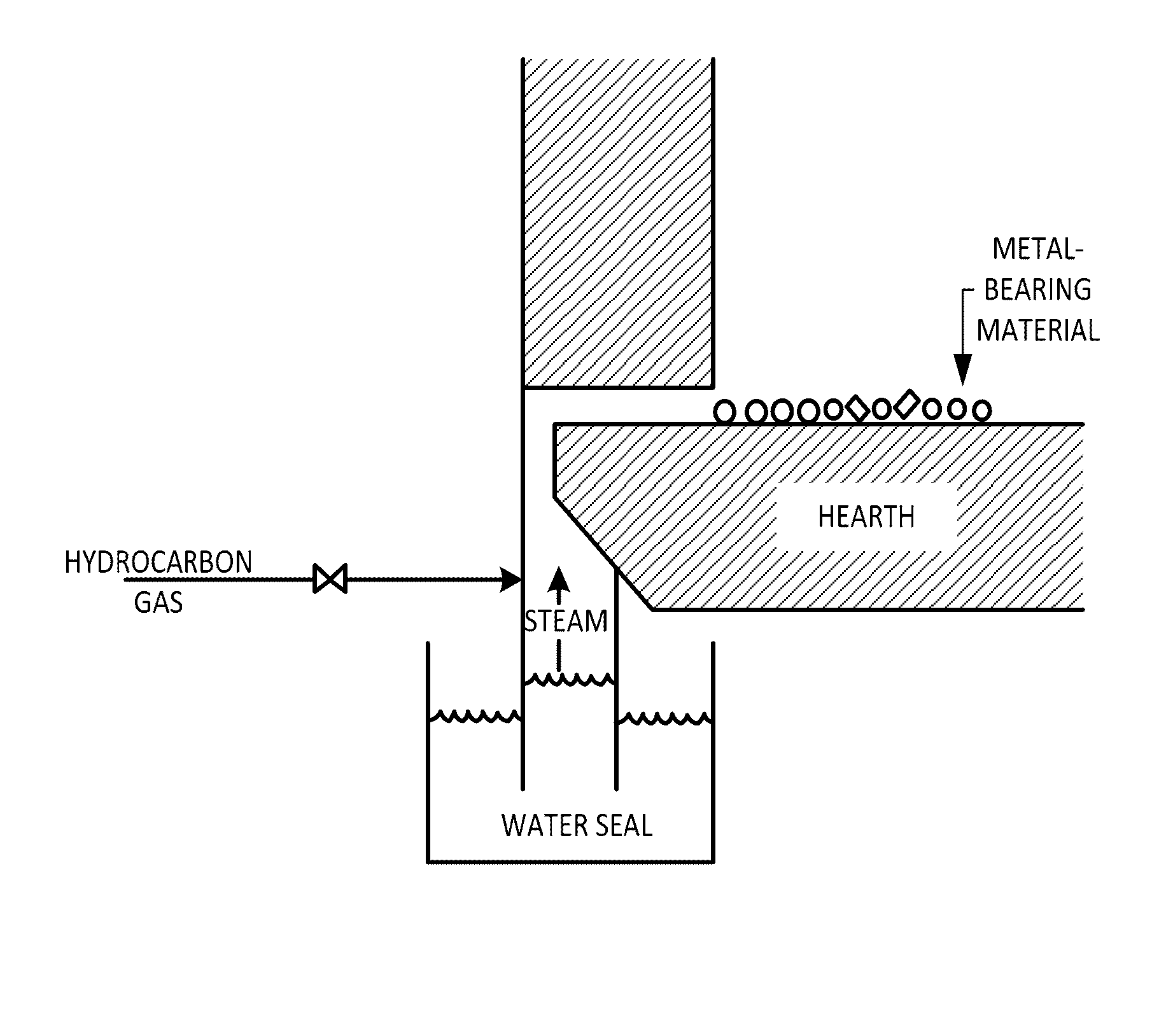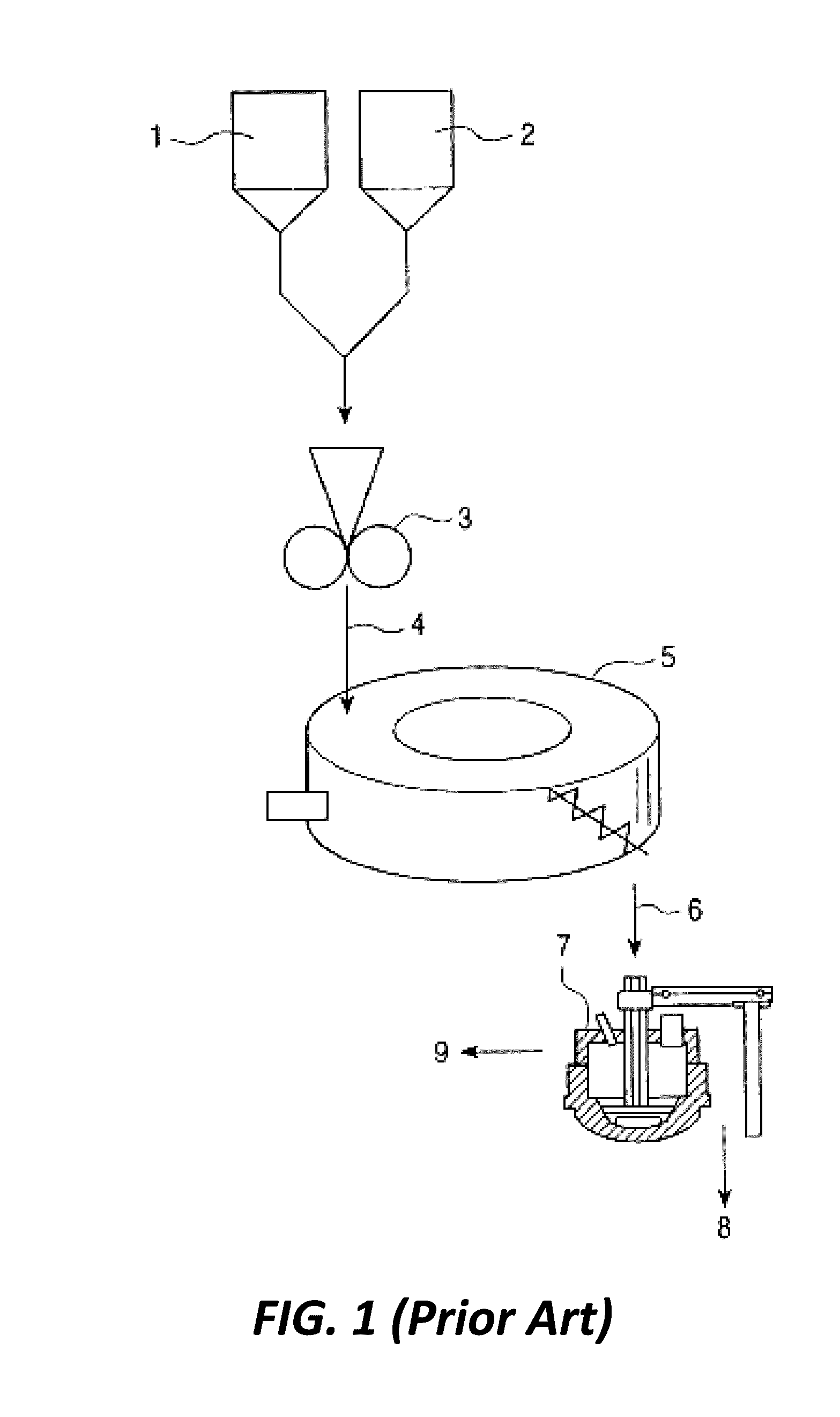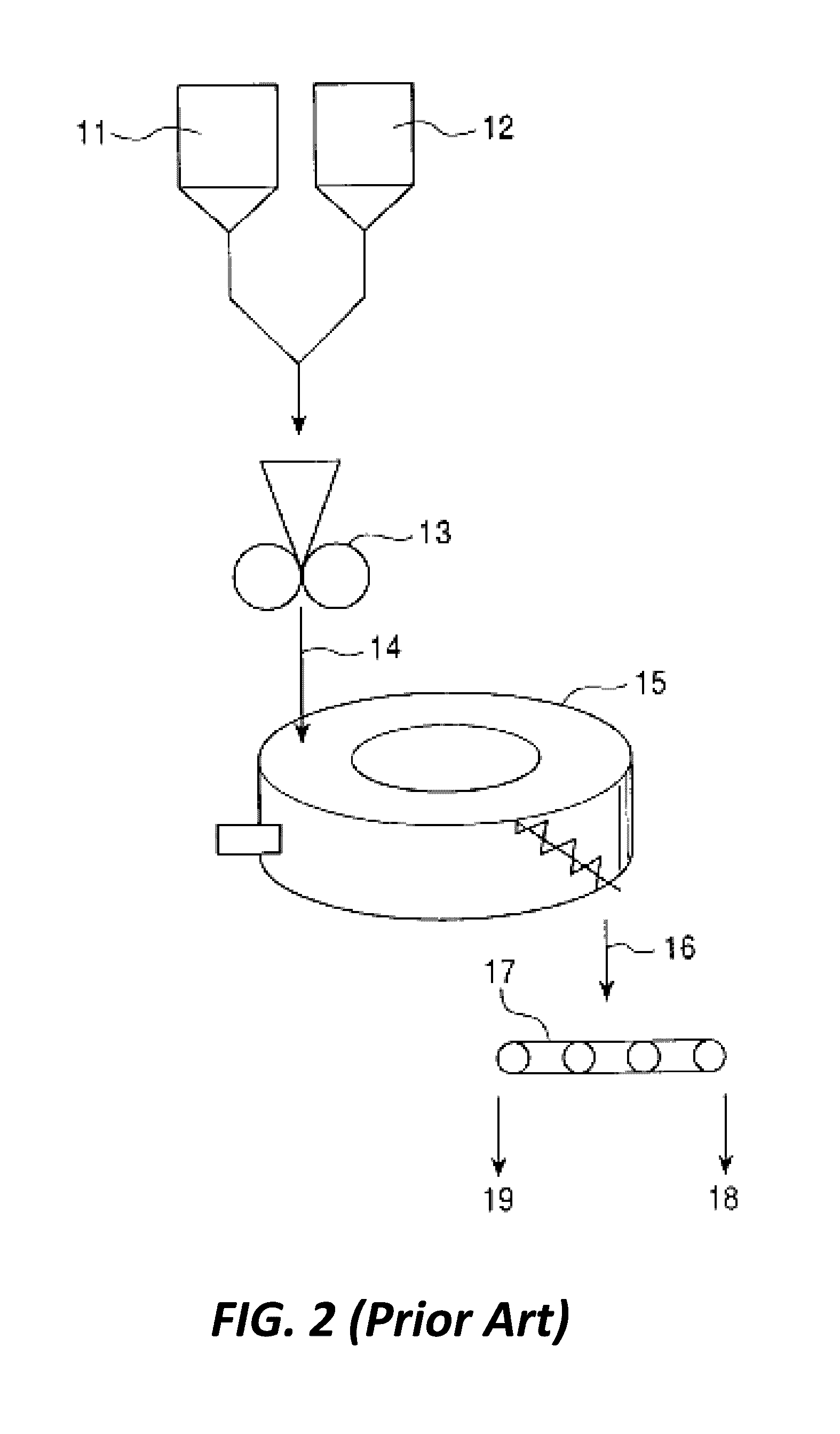[0015]If the temperature of the mixture is rapidly raised in the moving hearth furnace, the reduction of chromium oxide can be allowed to start before the internally added carbonaceous material in the mixture is consumed in the reduction of iron oxide. Accordingly, the reduction of chromium oxide proceeds while the contact opportunity between chromium oxide and the internally added carbonaceous material is maintained. This method can, therefore, provide a reduced mixture having a high chromium reduction degree. In particular, a moving hearth furnace in which a feedstock placed on the hearth is stationary is preferably used for the heating and reduction of the mixture. The use of such a furnace can significantly reduce the amount of dust produced and prevent dam rings due to dust deposited on the furnace walls. In addition, this furnace does not require extensive equipment as required for rotary kilns since the residence time of the mixture is uniform in the furnace. Accordingly, the equipment used is more compact and therefore provides the advantages of a smaller installation area and a less amount of heat dissipated.
[0016]In this implementation, the average rate of raising the temperature of the mixture in the reducing step is preferably 13.6 degrees C. / s or higher in the period from the initiation of the radiation heating of the mixture until the mixture reaches about 1,114 degrees C. A rapid temperature rise at this temperature raising rate provides the above effects more reliably. In this implementation, the reducing step is preferably performed at about 1,250 degrees C. to 1,400 degrees C. The reducing step in the moving hearth furnace at such a temperature allows efficient reduction of chromium oxide.
[0017]This implementation preferably further includes a reducing and melting step of melting the reduced mixture provided in the reducing step by successive radiation heating to provide a reduced molten material. The melting after the reduction causes the aggregation of metal and / or slag to reduce the surface area of the metal and / or slag and the area of the interface between the metal and slag, thereby reducing undesirable reactions, such as reoxidation. In addition, the melting following the reduction in the same furnace can avoid a temperature drop that occurs when, for example, the reduced mixture is discharged from the moving hearth furnace after the reduction and is transferred and melted in another apparatus. This method can therefore suppress energy loss in the melting of the reduced mixture.
[0018]This implementation preferably further includes a solidifying step of cooling and solidifying the reduced molten material provided by radiation heating in the moving hearth furnace to provide a reduced solid; and a separating step of separating the reduced solid into metal and slag. Accordingly, the mixture is reduced and molten in the moving hearth furnace, in which the feedstock placed on the hearth is stationary, to remove slag and recover metal from the mixture. This method therefore requires no smelting furnace, thus significantly reducing equipment cost and energy consumption. In this implementation, the melting step by radiation heating is preferably performed at a temperature higher than that in the reducing step within the range of about 1,350 degrees C. to 1,700 degrees C. The chromium content of the reduced mixture can be recovered as metal chromium contained in the metal, rather than removed as chromium oxide contained in the slag by allowing the reduction of chromium oxide contained in the reduced mixture to proceed sufficiently at about 1,250 degrees C. to 1,400 degrees C. before melting the reduced mixture at about 1,350 degrees C. to 1,700 degrees C. This method can therefore provide a high yield of chromium.
[0019]In this implementation, a carbonaceous atmosphere-adjusting agent is preferably charged together with the mixture onto the hearth of the moving hearth furnace in the reducing step. If the carbonaceous atmosphere-adjusting agent is charged together with the mixture onto the hearth, volatile components de-volatilized from the atmosphere-adjusting agent and gases such as CO and H2 produced in the solution loss reaction of CO2 and H2O contained in the atmosphere gas keep the vicinity of the mixture in a reducing atmosphere to prevent the re-oxidation of the reduced mixture. The volatile components and the gases, such as CO and H2, can also be used as fuels for the radiation heating in the moving hearth furnace to reduce the fuel consumption in the moving hearth furnace. In addition, the atmosphere-adjusting agent is converted into a carbon-based material that does not soften at high temperature after the de-volatilization. This material can prevent the buildup of deposits on the hearth to reduce the load on a discharger that discharges the reduced mixture (or the reduced molten material or reduced solid) and the abrasion of members such as cutting edges. Furthermore, the carbon-based material discharged together with the reduced mixture (or the reduced molten material or reduced solid) can be used as a reductant and / or heat source in the following smelting step.
[0020]However, in various exemplary embodiments, the present invention provides numerous improvements to this implementation. First, with regard to the agglomerates utilized, the agglomerates may be pellets, briquettes, or extrusions and the particle size is fundamentally important. The ore and the coal must be finely ground, with less than about 200 mesh (about 75 μm) size, for example. Low density and internal porosity are also fundamentally important, and can be provided by utilizing internal melting substances, such as paper fluff, Polystyrene / Styrofoam beads, or the like. It has been found that extruded hollows or the like with high aspect ratios are most advantageous, for both chromium ores and iron ores. The idea is to make extrusions with one or several holes (axially, for example) to facilitate heat transfer and gas evolution out of the extrusions. The use of binders, such as Bentonite, molasses, or the like; slag formers, such as Si for DRC strength, the formation of fayerlite FeSiO4, and the like; and fluxes, such as CaF2, NaOH, or the like, are all advantageous. Finally, the use of a protective layer on the agglomerates is important, such as providing a hard surface on the briquettes, or a coating before drying. This helps to prevent re-oxidation while allowing CO gas to escape, especially where the drying of a coating generates cracks that provide preferred escape routes for the CO gas.
 Login to View More
Login to View More 


